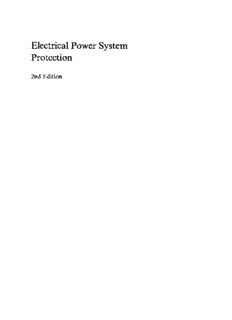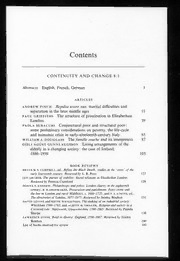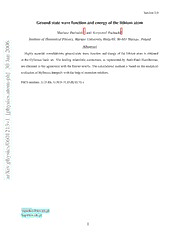
Electrical Power System Protection PDF
Preview Electrical Power System Protection
Electrical Power System Protection 2nd Edition Electrical Power System Protection 2nd Edition C. Christopoulos Professor of Electrical Engineering, University of Nottingham, Nottingham, UK and A. Wright (deceased) former Emeritus Professor of Electrical Engineering, University of Nottingham, Nottingham, UK SPRINGER-SCIENCE+BUSINESS MEDIA, B.V. Library of Congress Cataloging-In-Publication Data ChristopouloS, Chrlstos. Electrical power system protection / C. Christopoulos and A. Wright. p. cm. Wright's name appears first on the earlier edition. Includes bibliographical references and index. ISBN 978-1-4419-4734-5 ISBN 978-1-4757-5065-2 (eBook) DOI 10.1007/978-1-4757-5065-2 1. Electric power systems--Protectlon. 2. Electric power transmisslon--Equlpment and supplies--Protectlon. I. Wright, A. (Arthur) II. Title. TK1055.C474 1999 621.31'7--dc21 99-14201 ISBN 978-1-4419-4734-5 Printed on acid-free paper All Rights Reserved. © 1999 by Springer Science+Business Media Dordrecht Originally published by Kluwer Academic Publishers in 1999 Softcover reprint of the hardcover 2nd edition 1999 No part of the material protected by this copyright notice may be reproduced or utilized in any form or by any means, electronic or mechanical, including photocopying, recording, or by any information storage and retrieval system, without prior permission from the copyright owner. Contents Acknowledgements xv Preface to the Second Edition xvii Preface to the First Edition xviii List of Symbols xx 1 Fuses 1 1.1 Historical background 1 1.2 Basic requirements 5 1.3 Fuse types and constructions 6 l.3.l Cartridge fuses 7 l.3.2 Semi-enclosed fuses 8 l.3.3 Expulsion fuses 8 1.3.4 Liquid fuses 8 1.4 The behaviour of cartridge fuselinks 9 l.4.l The pre-arcing period 9 l.4.2 The arcing period 10 1.4.3 Determination of fuselink performance 13 l.5 The construction of cartridge fuses 14 l.5.1 Fuse elements 14 l.5.2 Fuselink bodies 16 l.5.3 Filling material 16 l.5.4 Mountings and ratings 16 l.6 Semi-enclosed fuses 18 l. 7 Expulsion fuses 18 1.8 Liquid fuses 21 1.9 The application of fuses 21 l.9.l Time/current relationships 22 l.9.2 J2t 23 l.9.3 Virtual time 24 1.9.4 Published time / current characteristics 24 l.9.5 Cut-off characteristics 25 l.9.6 Operating frequency 25 vi Contents 1.9.7 Discrimination and co-ordination 26 1.9.8 The protection of power-system equipment 28 1.1 0 The future 36 References 36 Further reading 37 2 Current transformers 39 2.1 Historical background 39 2.2 Conventional current transformers 42 2.2.1 Equivalent circuits 42 2.2.2 Behaviour under normal steady-state conditions 44 2.2.3 Behaviour under abnormal conditions 49 2.2.4 The effects of core saturation on transformation behaviour 59 2.2.5 Remanent core flux 62 2.2.6 Operation with a secondary circuit open or of a high impedance 68 2.2.7 The construction of current transformers 71 2.3 Linear couplers 77 2.3.1 The output of a linear coupler with a burden of infinite impedance 78 2.3.2 The output of a linear coupler with a burden of finite impedance 79 2.4 Current transformers with air-gapped cores 81 2.5 Non-conventional current transducers 82 2.6 Specifications and testing 84 2.7 The future 85 References 85 Further reading 86 3 Voltage transformers 87 3.1 Historical background 87 3.2 Electromagnetic voltage transformers 88 3.2.1 Behaviour during steady-state conditions 89 3.2.2 Behaviour during abnormal conditions 90 3.2.3 Voltage transformer construction 91 3.3 Capacitor-voltage transformers 94 3.3.1 Capacitor dividers 95 3.3.2 Circuit of a capacitor-voltage transformer 96 3.3.3 Steady state behaviour 96 3.3.4 Behaviour during abnormal conditions 97 3.4 Recent developments 98 3.5 Specifications and testing 99 3.6 The future 100 Contents VB References 100 Further reading 101 4 Overcurrent and earth fault protection 103 4.1 Historical background 103 4.2 Relay connections and operation 106 4.2.1 The detection of earth faults 106 4.2.2 The detection of overcurrents 107 4.2.3 Electro-mechanical relays lOS 4.2.4 Directional relays 113 4.2.5 Thermal inverse time/current relays 116 4.3 Electronic relays 117 4.3.1 Basic electronic processing liS 4.3.2 Current-operated relay 119 4.3.3 Directional relay 119 4.4 Applications of overcurrent, earth fault and directional relays 124 4.4.1 Current grading 125 4.4.2 Time grading using relays with definite operating times 126 4.4.3 Time grading using relays with inverse time/current characteristics 127 4.5 The application of directional and current-operated relays 135 4.6 Current and voltage transformers 139 4.6.1 Electro-mechanical relays with a fixed current setting 139 4.6.2 Electro-mechanical IDMT overcurrent relays 139 4.6.3 Electro-mechanical directional relays 140 4.6.4 Electronic relays 140 4.7 Standard specifications 140 4.7.1 IDMT relays 141 4.7.2 Directional relays 142 4.S The future 143 References 143 Further reading 144 5 Current-differential protective schemes 145 5.1 Historical background 147 5.2 Factors affecting current-differential schemes 148 5.2.1 Current transformer errors 148 5.2.2 Current transformer secondary ratings 150 5.2.3 Interconnecting cables (pilot wires) 150 5.2.4 Symmetry of protective circuits 151 5.2.5 The setting of low-impedance relays 154 5.3 The use of biasing features 156 5.4 Implementation of schemes 158 5.4.1 Units of short physical length 158 viii Contents 5.4.2 Units of considerable physical length 159 5.4.3 Balanced-voltage schemes 162 5.4.4 Schemes to protect zones with more than two ends 165 5.4.5 The protection of bus bars 167 5.5 Earth fault protective schemes 169 5.6 Schemes employing high-impedance relays 171 5.7 Relays used in current-differential schemes 174 5.8 Application of current-differential schemes 177 References 177 Further reading 177 6 The protection of transformers 179 6.1 Historical background 180 6.2 The construction and behaviour of transformers 180 6.2.1 Construction 181 6.2.2 Operation during normal and external fault conditions 184 6.2.3 Behaviour during internal fault conditions 191 6.2.4 Causes of internal electrical faults 194 6.3 The application of protective schemes and devices to power transformers with two or more windings per phase 198 6.3.1 Inverse time/current relays 198 6.3.2 Current-differential schemes 198 6.3.3 Restricted earth fault protection 208 6.3.4 Combined differential and restricted earth fault protection 210 6.3.5 Earth fault protection of delta-connected windings 211 6.3.6 Tank earth protection 212 6.3.7 Overfluxing protection 212 6.3.8 Protection against overheating 213 6.3.9 Buchholz relays 213 6.3.10 The protection of large three-phase transformers 216 6.4 The protection of earthing transformers 216 6.5 Auto transformers and their protection 219 6.5.1 Current-differential schemes 222 6.5.2 Tank earth protective equipment 223 6.5.3 Other protective equipment 223 6.6 The future 223 References 224 Further reading 225 7 The protection of rotating machines 227 7.1 Historical background 228 7.2 Protective devices and schemes 230 7.2.1 Fuses 230 Contents ix 7.2.2 Thermal relays 230 7.2.3 Thermal devices 231 7.2.4 Instantaneous electromagnetic relays 231 7.2.5 Current-differential schemes 232 7.2.6 Current-balance schemes 232 7.2.7 Phase-unbalance relays 233 7.2.8 Voltage-operated relays 233 7.2.9 Control equipment 233 7.2.10 Applications of protective schemes to machines 233 7.3 The protection of motors 234 7.3.1 The protection of small motors 234 7.3.2 The protection oflarge induction motors 235 7.3.3 The protection of synchronous motors 244 7.3.4 The protection of d.c. motors 251 7.3.5 The protection of variable-speed drives 254 7.4 The protection of alternators 255 7.4.1 Alternator construction and behaviour 255 7.4.2 The application of protective equipment to alternators 261 7.5 The future 278 References 278 Further reading 278 8 The protection of busbars 279 8.1 Historical background 279 8.2 Busbars 281 8.2.1 The construction of enclosed switchgear units 281 8.2.2 Open-type switching sites 283 8.2.3 Further methods to reduce the incidence of bus bar faults 283 8.3 Sectionalization 284 8.4 Faults on or near busbars 286 8.4.1 Internal faults 286 8.4.2 External faults 286 8.5 Positioning of current transformers and incorrectly protected zones 287 8.6 Protective arrangements for busbars 288 8.6.1 Application to simple single-phase unsectionalized busbars 289 8.6.2 Application to simple three-phase unsectionalized busbars 290 8.6.3 Application to complex three-phase sectionalized busbars 292 8.6.4 Interconnections in current-differential schemes applied to busbars 296 x Contents 8.7 Relays used in current-differential schemes 296 8.7.1 High-impedance relays 296 8.7.2 Low-impedance relays 297 8.7.3 Low-impedance relays with compensation for current-transformer saturation 299 8.7.4 The duplication of current-differential protective schemes 301 8.8 Manual and automatic testing 303 8.9 The future 304 References 304 Further reading 305 9 The protection of overhead lines and cables by current-differential schemes 307 9.1 Historical background 307 9.2 Cables and overhead transmission and distribution lines 310 9.3 The application of current-differential protective schemes 312 9.3.1 Comparison arrangements 312 9.3.2 Circulating-current schemes 315 9.3.3 Balanced-voltage schemes 317 9.3.4 Pilot wires 329 9.3.5 Protective schemes which use rented telephone circuits 330 9.3.6 Monitoring of pilot wires 331 9.3.7 Current-differential schemes incorporating optical-fibre links 333 9.4 The application of current-differential schemes to multi-ended circuits 337 9.5 The application of current-differential schemes to lines and cables terminated with transformers 340 9.6 The future 343 References 343 10 Interlock and phase-comparison schemes for the protection of overhead lines 345 Introduction 345 10.1 Historical background 346 10.2 The construction and behaviour of transmission lines 347 10.3 Features of interlock protective schemes 349 10.3.1 Relaying arrangements 349 10.3.2 Interlocking signals 360 10.3.3 Starting relay 361 10.3.4 Signalling channels 363 10.4 Interlock protective schemes 365 Contents xi 10.4.1 Reyrolle interlock protective scheme 365 10.4.2 Modern schemes 365 10.5 Features of phase-comparison protective schemes 367 10.5.1 The phase displacements ofline currents 368 10.5.2 The production of comparison signals 368 10.5.3 The comparison process 369 10.5.4 Comparison signals 371 10.5.5 Signalling equipment 371 10.5.6 Starting relays 372 10.5.7 Current transformers 372 10.6 Phase comparison schemes 372 10.6.1 Telephase protective schemes 373 10.6.2 Contraphase protective schemes 380 10.6.3 Other schemes 381 10.7 Auto-reclosing 381 10.8 The future 383 References 383 11 Distance-type protective schemes for overhead lines and cables 385 11.1 Historical background 386 11.2 The behaviour of overhead lines 387 11.2.1 The input impedance of a short single-phase line 387 11.2.2 The input impedance of a long single-phase line 390 11.2.3 The input impedances of a three-phase line 392 11.3 Impedance measurement 393 11.3.1 Relays dependent on the magnitude of impedance 393 11.3.2 Relay characteristics 395 11.3.3 The effects of system transients 400 11.4 Basic schemes 403 11.4.1 Application to three-phase lines 405 11.4.2 The detection of faults close to the input ends of lines 406 11.4.3 The settings of impedance-measuring relays 407 11.4.4 The operating times of relays 416 11.4.5 Relay performance standards 418 11.5 Conditions when a healthy line is affected by asynchronous system operation 419 11.6 Schemes applied in the past 422 11. 7 Present-day schemes 423 11.7.1 Optimho static-distance protection schemes 423 11.7.2 Distance protection relay 7SL32 424 11.8 The duplicate protection of transmission lines 425 11.9 The protection offeeder transformers 426
Description:The list of books you might like

The Sweetest Oblivion (Made Book 1)

Believe Me

A Thousand Boy Kisses

$100m Offers

MANUAL OF GRAPHIC TECHNIQUES 3 (ic anon uploaded)

GB 1796-1: Tyre valves -Part 1:Clamp-in valves

ERIC EJ1097751: Student Services Support of Developmental Education

Seeking Safety

Continuity and Change 1993: Vol 8 Table of Contents

Geoderma 2006: Vol 136 Table of Contents

DTIC ADA519804: Rumsfeld, the Generals, and the State of U.S. Civil-Military Relations

Kleypas Lisa - Stockeust 01 - 1995 - Cuore a cuore

Ground state wave function and energy of the lithium atom

UFO Newsclipping Service 2006 04 no 441

Экологический практикум. 5(6) класс

Kluftinger: Kriminalroman (Kluftinger-Krimis 10) (German Edition)

Sisi - Kaiserin wider Willen

A Bog at Walden Pond: Serendipitous Botanical History

(Calls will be routed to the appropriate branch via area





